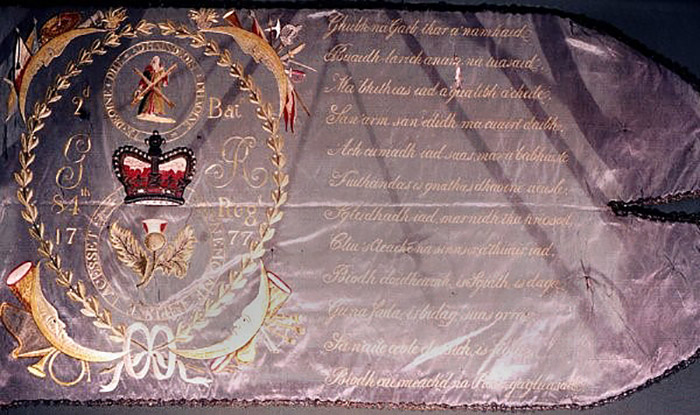
The late Roderick Cannon and I published an article in the pamphlet ‘West Highland Notes and Queries’, January 2013, concerning the ‘Maclean’ pipe banner [pictured above]. There was a translation by scholar Ronald Black of the Gaelic inscription in a subsequent issue of the publication.
Before we get to that I have another short tale that may be of interest and could pose the query: ‘Did his pipes get wet?’
Among the MacLean of Lochbuy papers from the late 18th century is a bundle of letters from Lachlan Macquarie, then on the island of Little Colonsay where he was staying having lost his estate of Ulva to creditors. [The Macquaries were the predominant family on Ulva, their most famous scion being Lachlan Macquarie, the first Governor of New South Wales, and considered the founding father of Australia.]
One letter in particular, dated 7 January 1795, is of piping interest. Having started with a mention of one of his relatives regarded as suitable for the military, he then turns to more general news, in particular the fact that ‘poor Coll had a narrow escape yesterday on the coast of Staffa where he is lying in a very dangerous state with your old piper and a girl, who by all accounts will never recover’.
It would appear that they were all on a boat overturned by waves while entering the ‘harbour’ and then cast ashore. Given the date, Coll’s piper would have been Neil Rankin mentioned in earlier articles on Piping Press. The description, ‘your old piper’, with ‘old’ in the sense of ‘former’, would support the idea that Neil Rankin first served MacLean of Lochbuy before moving to serve MacLean of Coll.
The 84th’s Pipe Banner
Pipe banners have never been studied as a specific subject. Even among military historians they at best get mentioned in passing as little more than evidence that various regiments had pipers. In modem times, non-military banners have appeared usually with civilian pipe bands or relatively modem ‘estate pipers’.
Ironically this latter use may be the original purpose, as one of the earliest depictions is in the famous painting of the Laird of Grant’s piper from 1714. Accounts among the Gordon and Atholl estate papers suggest that the employers’ armorial banners were originally used to adorn their pipers instruments. In military use however, banners tend to have more the character of regimental colours.
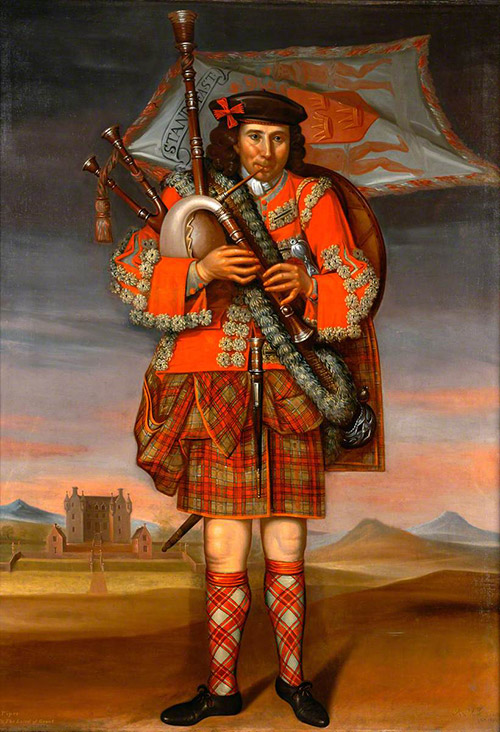
An unusually interesting example of a regimental pipe banner is the one which is the main subject of this article, the banner of the 84th Royal Highland Emigrants. They were raised at the start of the American War of Independence. The regiment had a short life, from 1775 to 1783 only, but the banner is preserved, and, strange as it may seem, is in the Museum of the York and Lancaster Regiment at Rotherham, Yorkshire. This comes about as this regiment was in due course also numbered ‘the 84th’ and fortunately for us the museum inherited the banner.
While it is not unusual to find pipe banners with regimental or clan mottos in Latin, Gaelic or English, what makes this one unique is that, as far as we know, it is the only one to have an extended Gaelic text, twelve lines of verse apparently composed especially for it. The translation by Ronald Black reads:
‘The Gael will obtain against the enemy
Battle victories in time of war
If shoulder to shoulder they remain
With their arms and their dress around them.
‘But may they maintain, as was their wont,
The appearance and ways of gentlemen,
And may they keep as a priceless inheritance
The fame and use of these things that they’ve got.
‘May they wear sword and shield and pistol.
Long gun and dirk in full display,
And instead of the music of harp and fiddle
May the march of the bagpipe inspire them.’
The 84th was raised by Lieutenant Colonel Allan Maclean (of the Torloisk family), in two battalions. The pipe banner belonged to the 2nd Battalion and with the following evidence it is possible to narrow the date of manufacture to circa 1776-77.
Captain Murdoch Maclean, (a cousin of Lochbuy), was sent back from America to Britain to organise the second battalion’s equipment. It had been caught in a sort of limbo due to uncertainly over which particular establishment it was on, the result being that it received no uniforms or other regimental equipment until Captain Maclean returned.
He had left from Boston on the 1st February and reached London in just three weeks. Apart from organising the regimental equipment he also, through the offices or his cousin Archibald Maclean, younger of Lochbuie, acquired a young piper from Mull called Neil Gillies alias Maclean.
From the surviving correspondence it is clear that the piper was sent from Mull to meet Captain Maclean in Edinburgh sometime around the end of April or the beginning of May. Eventually, Captain Maclean, along with the regiment’s supplies and some more recruits, sailed from Glasgow in the autumn of 1776 arriving at Halifax, Nova Scotia, in late October.
We can also consider the question of where the banner was made. The poem is on the part of the banner nearest to the hoist (which in this case is presumably the bass drone of the pipe), and apart from this there is a large cartouche [ornate frame] made of linked leaves with corners formed by quarter moons embellished with musical instruments and weapons.
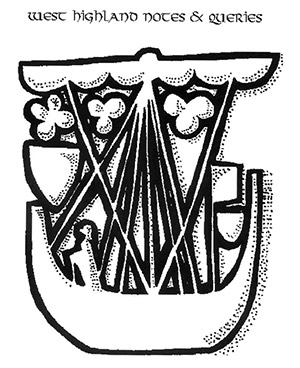
This encloses two ‘regimental badges’, the lower being a thistle surmounted by a crown, the badge of the 84th, while the upper one has St Andrew holding a cross, presumably for the second Battalion, along with the regimental numbers including a date of 1777.
Dates on military flags usually refer to either the date on which a regiment was first raised, or Battle Honours acquired during service, but neither of these seem relevant here. It is possible to suggest an explanation if the date on the pipe banner was a projected date when it would first become relevant, but for this we have to return to the period when Captain Maclean was organising the equipment for the 2nd Battalion during 1776.
Considering that Captain Maclean had been a successful merchant before taking up a commission, his company account books can only be called a mess. However, the first one in which the piper appears has payments running from May 1776 to Feb 1777. This includes an entry to ‘your Pype and other Furnishings till allowed by the Commanding Officer £4 13sh 4d.
Since it is clear from another entry for the same period that shoes were also bought for the piper while in Edinburgh, it is likely that the ‘furnishings’ for the pipe include the banner and it too was made there. The Captain would undoubtedly have been aware that until he returned with their uniforms the regiment he had left were in breeks, or to put it more bluntly, old provincial uniforms mostly rags.
It would be the beginning of 1777 when the regiment would first parade fully kitted out as a Highland regiment wearing their Highland dress – a suitable date to celebrate.
Ronald Black in his comments: ‘Strange as it may seem, the banner is in the museum of the York and Lancaster Regiment at Rotherham in Yorkshire. To my mind this is fitting, because the Marquis of Graham who moved the repeal of the Disarming and Disclothing Acts and carried his bill without opposition, was MP for Richmond in the same county. He was much praised by Gaelic poets for his initiative at the time. Now… we may add the pipe-banner song to the already substantial corpus of Gaelic verse on the enactment, operation and repeal of those odious laws against the Highland dress.’











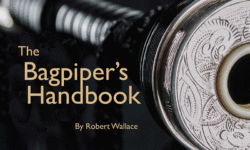
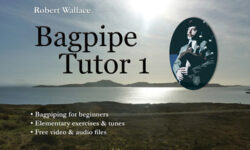








I recently received a link to this ‘background to the 84th’s pipe banner’. I would like to add some relevant corrections.The Captain Murdoch Maclean mentioned was in fact Captain Murdoch Maclaine who succeeded his cousin Archibald to become the 19th Lochbuie chief. (Archibald had died in a duel without leaving any legitimate heirs). Beyond this nomenclature error, the story is correct.